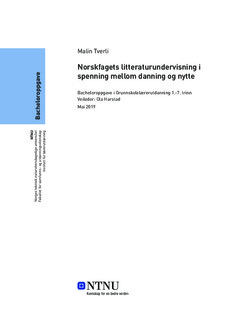| dc.contributor.advisor | Harstad, Ola | |
| dc.contributor.author | Tverli, Malin | |
| dc.date.accessioned | 2019-08-23T14:06:14Z | |
| dc.date.available | 2019-08-23T14:06:14Z | |
| dc.date.issued | 2019 | |
| dc.identifier.uri | http://hdl.handle.net/11250/2610164 | |
| dc.description.abstract | Denne bacheloroppgaven er en analyse av spenningen mellom danning og nytte innenfor litteraturdelen av norskfaget i den gjeldende læreplanen; Læreplan for Kunnskapsløftet (LK06), og den foregående læreplanen; Læreplanverket for den 10-årige grunnskolen (L97). Problemstillingen for oppgaven er som følger; hvordan kommer spenningsforholdet mellom litteraturundervisningens danning og nytte til uttrykk i L97 og LK06? I oppgaven presenteres ulike tilnærminger til danning og nytte i dagens skole, og norskfaget settes i en historisk sammenheng for å kunne trekke linjer både bak og frem i tid. Analysen fokuserer på spenningsforholdet mellom danning og nytte i faget, og i drøftingsdelen tar jeg danningsspørsmålet et steg videre og drøfter funnene i lys av den kategoriale danningsteorien til Wolfgang Klafki. Funnene i oppgaven tyder på to ulike tilnærminger til danning og nytte i utdanningen, hvor L97 virker å ha et lavt spenningsforhold mellom danning og nytte, da dette kan sees som to dimensjoner ved utdanningen som skal spille på og med hverandre, mens LK06 tydelig har et større spenningsforhold mellom de to dimensjonene da danningen kan sees som mer overordnet, og i lite samsvar med de spesifikke målene for faget. L97 heller mer mot en material danning, mens LK06 er mer formal. Begge læreplanene har mangler innenfor danningsdimensjonen i lys av den kategoriale danningsteorien, og vilkårene for at danning skal forekomme kan i begge læreplanene se ut til å være opp til læreren. | |
| dc.description.abstract | This bachelor thesis is an analysis of the tension between bildung and learning of utility or useful skills in the literature-section of the Norwegian subject in the present curricula; Læreplan for Kunnskapsløftet (LK06) and the previous curricula; Læreplanverket for den 10-årige grunnskolen (L97). The question I want to answer is this; How is the tension between the literature-sections bildung and utility expressed in L97 and LK06? In the paper I present different approaches to bildung and utility, and I put the Norwegian subject in a historical context to be able to draw lines. The analysis focuses on the tension between bildung and learning of useful skills/utility in the subject, and in the discussion section of the paper I take the question about bildung further and discusses the findings in the analysis in light of Wolfgang Klafkis theory on education. The findings in the paper indicates two different approaches to bildung and utility in education, whereas L97 seems to have a low tension, they are seen as codependent dimensions of education. LK06 on the other hand seems to have more tension between the dimensions because bildung is seen as a superior part of the subject which does not conform with the specific goals of the subject. L97 is leaning towards a material bildung, while LK06 is more formal. Both curricula have flaws when it comes to the dimension of bildung in light of Wolfgang Klafkis theory on education, and the terms for occurrence of bildung seems to be depending on the teacher in both curricula. | |
| dc.language | nob | |
| dc.publisher | NTNU | |
| dc.title | Norskfagets litteraturundervisning i spenning mellom danning og nytte | |
| dc.type | Bachelor thesis | |
